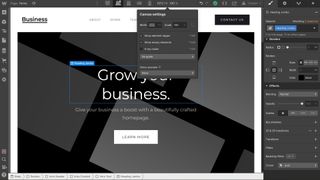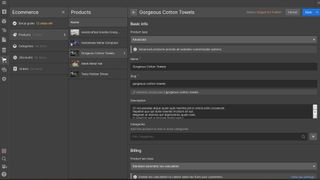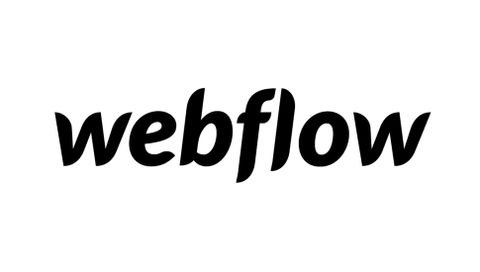IT Pro Verdict
Webflow is an extremely capable website builder with a lot to offer for web developers and experienced designers.
Pros
- +
Flexible site editor with breakpoint control
- +
Built-in CMS
- +
Integrated development environment
Cons
- -
Complex pricing options
- -
Email support only
Webflow is an advanced website builder that enables you to create a custom website or online store. In our Webflow review, we’ll take a closer look at what this platform can do, and help you decide if it’s the best website builder for you.
Webflow review: Snapshot
Webflow is a powerful website builder that’s best suited for web developers, design agencies, and experienced website designers.
In addition to a drag-and-drop site editor, Webflow offers comprehensive tools to control every aspect of your site design. You can control content breakpoints to create a responsive mobile site. You can also add CSS and Javascript using an integrated development environment to create dynamic website elements.
Perhaps the best feature within Webflow is its CMS. This enables you to store all of your website data, including images, products, digital records, and more, in a searchable database. The CMS also makes it simple to import and deploy content across your site.
Webflow can be very pricey, but you’ll be hard-pressed to find a more capable platform. Editor X comes close, and we think it offers better tools for collaboration within small teams. However, Editor X doesn’t offer a built-in CMS, so it’s not as suitable for creating large, data-heavy websites.
Score: 4.5/5
Read on for our full and detailed Webflow review.
Webflow’s competitors
How does Webflow compare to its main competitors?
| Header Cell - Column 0 | Webflow | Editor X | Wix |
|---|---|---|---|
| Score | 4.5/5 | 4.5/5 | 4.5/5 |
| Pros | - Built-in CMS - Very powerful site editor | - Simultaneous editing - Compatible with Wix apps | - 800+ templates - Beginner-friendly |
| Cons | - Complicated pricing - Email support only | - Limited number of templates - Content storage limits | - Difficult to design mobile-responsive sites - Limited collaboration tools |
| Verdict | Webflow is a powerful website builder that’s best-suited for web developers and advanced designers. A built-in CMS makes it ideal for larger websites. | Editor X offers fine-grained control over your website and enables simultaneous editing by multiple designers. It’s ideal for teams of web developers or design agencies. | Wix is a beginner-friendly website builder that trades some design control for ease of use. It includes more than 800 templates and access to an app marketplace. |
| View deals | Visit site | Visit site | Visit site |
Webflow: Key features
Let’s take a look at some of the key features that set Webflow apart from other website builders.
Webflow enables you to directly edit the breakpoints of your site. Breakpoints control how content elements are resized and rearranged as the viewer’s screen size changes. By modifying breakpoints, you have total control over how your site will look on a mobile device, a tablet, or even a large desktop monitor.

Webflow automatically writes HTML5 in the background as you design your site using the visual drag-and-drop editor. However, you can also edit your site’s code directly using an integrated development environment.
The integrated development environment enables you to write HTML5, CSS, and Javascript. You can directly edit the code behind any content element just by clicking on it in the visual editor. You can also create dynamic interactions like parallax scrolling or page load animations, and customise them using the integrated development environment.

Webflow includes a built-in CMS that enables you to organise and deploy data across your site. You can import any type of data—including images, products, customer records, blog posts, and more—into your CMS as records, and group them into searchable databases.
Content added to your site from the CMS works dynamically. For example, you can choose what products to display in a featured content box based on a visitor’s location and geotags added to your product records. After you deploy content on your site, you can edit all instances of a specific piece of data on your site just by editing its entry in the CMS.

Webflow’s CMS supports custom fields, so there are few limits on how you can structure and tag your site’s data. The builder also enables you to sell physical and digital products. You can set up shipping, enable in-store pickup, or offer digital downloads or email deliveries. Webflow doesn’t currently offer digital subscriptions, but the company says it plans to offer this soon.
It accepts payments using PayPal, Stripe, Apple Pay, and Google Pay, and also handles tax and shipping calculations automatically. You can integrate your online store with any app supported by Zapier, including Quickbooks and MailChimp.

Webflow: What’s new in 2022?
Webflow has made two important changes over the past year. First, the platform redesigned its CMS to make it significantly faster. According to Webflow, projects using the CMS now load 15 times faster in the Webflow editor, and use six times less RAM. That means your site’s back-end performance won’t suffer as you add more records to your CMS.
It has also enabled simultaneous editing by multiple designers. You can see where other contributors are working on your site, similar to how you can see where other editors are working in a Google Doc. However, you still can’t leave notes or chat in real-time like you can with Editor X.
Webflow: Pricing
Webflow offers two different types of plans: Site and Workspace plans, with Site plans split into site-specific and ecommerce plans. You add a separate Site plan for each website you want to create.
A Site Starter plan is free for up to two sites with two pages each, and all Site plans enable you to connect a custom domain to your website. All are billed per website, and there are plans for both basic websites and online stores.
The Basic plan costs £12.29 a month, but it doesn’t include access to Weblow’s CMS. For that, you’ll need a CMS plan for £16.39 a month. The Business plan costs £36.88 a month, and offers access for up to 10 content contributors and bandwidth for up to 500,000 monthly visitors.
For ecommerce, the Standard plan costs £34.42 a month, and enables you to sell up to 500 items with a 2% transaction fee. The Plus plan costs £68.84 a month, and enables up to 1,000 items with no transaction fee. The Advanced plan costs £192.60 a month, and enables up to 3,000 items with no annual revenue limits.
For multiple sites and collaborative site creation and managment, you'll need a Workspace plan on top of a Site one. There are three, starting with a free plan and moving up to Core and Growth, at £22.95 and £49.17 a month respectively, with increasing numbers of seats, unhosted sites, permissions and code export tools.
All Webflow plans can be paid monthly or annually, and enterprise packages are available via sales contact.
Webflow’s pricing plans
| Plan type/ feature | Site Starter | Site Basic | Site CMS | Site Business | Ecommerce Standard | Ecommerce Plus | Ecommerce Advanced | Workspace Starter | Workspace Core | Workspace Growth |
|---|---|---|---|---|---|---|---|---|---|---|
| Cost per month | Free | £12.29 | £16.39 | £36.88 | £34.42 | £68.84 | £192.60 | Free | £22.95 | £49.17 |
| Cost per year | Free | £118 | £157.52 | £432 | £147.52 | £727.79 | £2,085.01 | Free | £186.86 | £481.91 |
| CMS items | 50 | 0 | 2,000 | 10,000 | 500 | 1,000 | 3,000 | N/A | N/A | N/A |
| Bandwidth | 1GB | 50GB | 200GB | 400GB | 200GB | 400GB | 400GB | N/A | N/A | N/A |
| Ecommerce | ✖ | ✖ | ✖ | ✖ | ✔ | ✔ | ✔ | N/A | N/A | N/A |
Testing Webflow
We built a site from scratch using Webflow to find out how easy this builder is to use.
How easy is Webflow to use?

Getting a website off the ground with Webflow is more time-consuming than with other website builders we’ve tested. The platform has a steep learning curve, and the sheer volume of design options means that it’s not possible to simply add a few images and click publish.
That said, we were impressed with how straightforward Webflow is to navigate once you get used to it. A sidebar menu gives you access to all of the editor’s main features: new content elements, page settings, your CMS, and ecommerce settings. Click on any content element on your site, and another design menu will give you all of the options for editing that element.
One thing we especially liked about Webflow is the way it organises content on your pages. You can create an unlimited number of containers, each of which can contain an unlimited number of content elements. You can set default properties for each container, which saves time modifying each element inside of it.
Webflow also supports layers, making it easier to create unique designs with overlapping content.
How responsive is Webflow’s support?

Webflow only offers customer support by email from Monday–Friday. We emailed and got a response within 24 hours.
The platform’s online tutorials are comprehensive and well-organised. A series of more than 40 short videos walks you through everything you need to know to get started with Webflow. A detailed online knowledgebase offers even more information, and is packed with short video clips.
Alternatives to Webflow
Webflow is a powerful website builder aimed specifically at web developers, design agencies, and experienced website creators. However, it’s not the only platform targeting this demographic.
Editor X, a relatively new platform from the makers of Wix, offers just as much design flexibility as Webflow and has a similar integrated development environment. Editor X beats out Webflow when it comes to collaboration. While both platforms enable simultaneous editing, only Editor X enables you to leave notes on content elements and chat with other editors while you work.
However, Editor X doesn’t have a built-in CMS. You can create databases in Editor X, but each database is managed individually rather than integrated into a site-wide framework. For larger sites with a lot of images, products, and other digital records, Webflow offers more ways to work with your data.
If you don’t need all the advanced features that Webflow and Editor X offer, you might consider Wix. This beginner-friendly site builder that doesn’t require any coding to customise your website. You won’t have control over content breakpoints, but sites are mobile responsive by default, and you do have some flexibility to edit your mobile site.
Another nice thing about Wix is that it’s relatively inexpensive. Basic website plans start at £11 a month compared to £12.29 a month for Webflow. Ecommerce plans at Wix start at £15 a month compared to £34.42 at Webflow.
Webflow’s features compared to the competition:
| Header Cell - Column 0 | Webflow | Editor X | Wix |
|---|---|---|---|
| CMS | ✔ (with upgrade) | ✖ | ✖ |
| Simultaneous editing | ✖ | ✔ | ✖ |
| Support | Email, Monday–Friday | 24/7 phone and email | 24/7 phone and email |
| Basic plan | £12.29 a month | £15 a month | £11 a month |
Webflow: Final verdict
Webflow is an extremely capable website builder with a lot to offer for web developers and experienced designers. With Webflow, you get total control over the design of your site. The drag-and-drop editor is augmented with layers and containers to organise your content. Breakpoint editing ensures that your site looks just as you want it to on any device.
In addition, Webflow gives you access to an integrated development environment and built-in CMS. These tools make it possible to create dynamic pages, and to easily deploy content across your site. They’re particularly useful for larger websites with a lot of data to keep organised.
Keep in mind that Webflow is not made for first-time web designers. The platform is fairly easy to use, but the powerful design tools come with a steep learning curve. While you don’t necessarily have to code to create a website with Webflow, you’ll get much more out of the platform if you take advantage of the integrated development environment. The CMS works best if it serves as a shared resource for designers, content strategists, and developers.
Webflow can be very expensive, but we think it’s the best platform available if you want total design control and a CMS integrated into your website. Editor X offers similar design flexibility, but its individually managed databases aren’t as flexible as Webflow’s CMS. Wix lacks many of the advanced design tools that Webflow offers, and is targeted much more towards first-time site creators.
Further reading on website builders and web hosting
Want to learn more about website builders? Check out this guide on how to build an ecommerce website, and find out who the best ecommerce website builders are, and whether Shopify ranks among the best small business website builders. Finally, take a look at the best web hosting services if you've got web development experience and want more flexibility.
If you're considering the best WordPress hosting for your WordPress site, make sure to look at our listicles outlining seven great reasons to choose managed WordPress hosting, and the four S's of managed WordPress: security, scalability, speed, and service.
Michael is a prolific author in business and B2B tech, whose articles can be found on Business Insider, Entrepreneur, TechRadar Pro, IT Pro Portal, Tom's Guide, and more, covering everything from international tech regulations to corporate finance and emerging tech brands and markets. A successful copywriter and entrepreneur, Michael has worked with dozens of SaaS and tech companies, and has his finger firmly on the pulse of B2B tech, finance and business.


